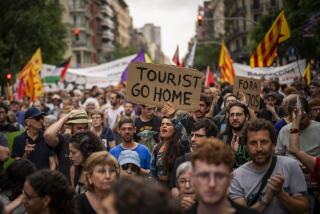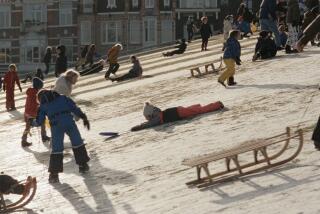Rembrandt’s Amsterdam
AMSTERDAM — He was an artist, a true genius whose gift continues to enlighten and intrigue us 400 years after his birth.
I mean, just look at “The Nightwatch.” The portraits. A box of Dutch Masters cigars.
Rembrandt was also, at times, a lout, a drunkard, a skinflint, an unfaithful husband (who fathered a daughter out of wedlock), a pornographer and a notoriously bad businessman.
The life and lifestyle of this city’s favorite adopted son--whose Big 4-0-0 had banners flapping everywhere here last summer and which gave us a good excuse to revisit--may not entirely parallel the ongoing reality of Amsterdam, but it’s sure close enough. For no great European city, and you know who they are, puts hedonic excess and well-worn charm in such proximity, and with such unrestrained and unapologetic joy.
“Biggest tourist attraction in Amsterdam,” declared a hotel concierge bubbling with pride. He was not talking about Rembrandt. He was talking about whores and dope. “When you get home, they’ll always ask you, Did you go to the `coffee shop’? Did you go to the Red Light District?
“If you haven’t seen them, you haven’t seen Amsterdam.”
After our brief conversation, I dodged bicycles, ignored intoxicant smog and merely glanced instinctively at the professionals behind the glass and found--two blocks from the hotel--a dreamy dinner at an outside table along a picture-book canal . . .
What a city.
Our focus on this visit, because of the timing, was Rembrandt--full name Rembrandt Harmenszoon van Rijn, 400, born July 15, 1606, son of a miller in nearby Leiden and literally a monumental presence in his eventual hometown.
And even if the actual birthday party has ended since our visit and the banners have been replaced by whatever’s next (the 69th Anniversary of Johnny Vander Meer’s Back-to-Back No-Hitters?), that doesn’t mean the Amsterdam’s Celebration of Rembrandt has been discontinued.
There will always be a Rembrandtplein.
For this story, we more or less followed the Rembrandt Self-Guided Walking Tour set out in a brochure provided by the Amsterdam tourism people, so here we go--after this brief message about bicycles.
“Here in Amsterdam, cars properly stop,” cautioned guide Ton Jongenelen, who led a group of us on a city tour a couple of days earlier. “No problem. They have to pay a higher insurance fee if they hit you.
“Bicycles, however, are everywhere. They don’t respect any rule, so they can be on a sidewalk, and they pass through the red--always.
“I can guarantee you they never, ever stop. They get bonus points for hitting innocent, unaware American, Canadian, English or most any tourist. You mark it on your bike like a fighter pilot on his plane. Four a day is a nice, average score . . .”
Properly warned, we’re starting our Rembrandt Walk at Rembrandt’s house, a short, bike-resistant tram ride from city center.
Like most Amsterdam buildings other than those built last Tuesday, the house is predominantly dark brick and with little adornment. As a house, it was a big one for its time. And expensive to maintain. Rembrandt eventually had to sell the place to keep food and genever (Dutch gin) on the table, but it’s been restored to what it was when he was doing great work--and peddling self-portraits to his fans for loose guilders.
On its interior walls are examples of his paintings and those of contemporaries and teachers, including Pieter Lastman. More enlightening is a generous sampling--more than a hundred--of Rembrandt’s etchings, along with explanations of the process, which is more fascinating than you’d think. (He etched at least 31 self-portraits, which is a lot of mirror-time. Many, as postcards and notecards, are for sale in the gift shop. He would be delighted.) This gallery changes periodically, but it’s always etchings and always Rembrandt.
Hint: To really appreciate the etchery, bring a magnifying glass. People do that.
We also get a look at his studio and his collection of props, the flotsam of illustration: shells, busts and other objects, as well as fellow artists’ drawings and prints.
Leaving the house with our postcards tucked, we pass and inspect more remnants of Rembrandt’s time: the Zuiderkerk, the church whose graveyard holds the remains of three of Rembrandt’s children; the Trippenhaus, a vanity house built around 1660 by merchant brothers, later a museum; Nieuwmarkt, a still-lively marketplace (with some treasures, maybe, among the junk sunglasses); and the Waag, a chateaulike building already old in Rembrandt’s time, home then to local guilds and to a surgical theater portrayed in one of the artist’s breakthrough paintings.
Which leads us, inevitably, to the Red Light District.
Link to Rembrandt? Well, there were some scandalous etchings . . .
Most of the red lights and the professionals beneath them are on narrow, moody side-streets--but there are some blocks with concentrations of bright sign-age signaling bars, “coffee [smoke] shops” and porn shops. The bars offer what bars offer, the smoke shops offer more than Marlboros, and the porn shops are not all that much different from your own neighborhood porn shop, except here people bring their dates inside--which adds audible giggles, some from the girls.
On Saturday nights, these liberated streets are packed with people, many staggering under various influences and others just taking in the scene.
This morning, it being Sunday, the streets, mostly deserted, smell like beer and urine.
Not far from this sensory delight, opposite the Oude Kerk--the Old Church (c. 1300), resting place of Rembrandt’s wife, Saskia--is the High Time Coffee Shop. The shop is open; the church is closed.
Moving right along . . .
Dam Square, with its hotels, confluence of tram lines and the Royal Palace, is--as it was--the heart of the old city. Lots of young folks just hang out here, and you can usually grab a quick hot dog off one of the stands. The Nieuwe Kerk (as opposed to the Oude one) is here, and nieuwe as it is, it’s still oude enough (c. 1400) to have been site of Rembrandt’s wedding.
Anne Frank’s house. What does Anne Frank’s house have to do with Rembrandt? Nothing, but it’s just a couple of blocks away, the line today is reasonable (less than a half-hour), and it’s Anne Frank’s house.
“You’ve known for a long time that my greatest wish is to be a journalist ...”
Editions of her diary available in the gift shop: Bulgarian, Latvian, English, Dutch, Turkish, Hungarian, Danish, Estonian, Swedish, Norwegian, Greek, Hebrew, Catalan, Spanish, Basque, Italian, Japanese, Korean, French, Portuguese, German, and I probably missed a couple.
A bit of a hike, powered by a sampling of Amsterdam’s most familiar malt beverage, finds the city museum in what was, in Rembrandt’s time, the Burgerweeshuis, the city orphanage. Most interesting is a walkway gallery featuring group portraits of various regiments of civic guards. Rembrandt was commissioned to paint one of these groupings--which we now know as “The Nightwatch” (or “The Night Watch,” depending on the translation).
Seeing these, which are quite proficient though static, and seeing that, helps you understand the particular genius of the man from Leiden.
Then we discover the Spui, a sweet little square, and the streets leading into it, which together provide Paris-style cafes, restaurants of various ilks (including the celebrated d’Vijff Vlieghen), bookstores and benches at which to gather and stare at the people sipping at the Paris-style cafes.
A couple of more turns and after a peek into the very spiffy Hotel de l’Europe, we walk past No. 18 Nieuwe Doelenstraat, where Rembrandt and the Missus lived for a few years. A few steps down the street is the Doelen Hotel, where “The Nightwatch” lived for a few years.
“Where did ... ?” I didn’t finish the question.
“If you walk up to the first floor, and then left,” explains the young lady at the front desk.
“How many people ask that question in a week?”
“I don’t know,” she says, “but many, many.”
Up to the first floor and then left--across from the Rembrandt Salon--is the wall where the great work hung from its completion in 1642 until 1715, when it was moved to the town hall on Dam Square (where, incredibly to us 292 years later, it was trimmed to fit).
On that hotel wall now: a shadowy but just effective-enough representation of what was there from 1642 until 1715.
And if that, and the postcards and the now-removed birthday banners aren’t sufficient, there’s Rembrandtplein--a smallish park-like square just across the Amstel River.
Here’s where you’ll find a statue of the artist--and, held over from ‘06, a reproduction (in the form of life-size statues) of “The Nightwatch.” Plus a steady stream of tourists posing alongside them for silly pictures.
And if that’s not enough:
The actual painting is in the Rijksmuseum. Which, if you’re a good walker, is within walking distance of the statues--and worth the walk.
Because just when you’re starting to think you’re Rembrandted out, the Van Gogh Museum is right down the path. Paintings that make you cry.
And right outside the door of the Van Gogh Museum: the tram to the Red Light District.
What a city this is ...
- - -
IF YOU GO
GETTING THERE
KLM, Northwest and United Airlines offer non-stops from O’Hare to Amsterdam, though some service is seasonal. Expect to pay about $1,350 during summer tourist season, around $1,000 on the fringes (and as low as $650 in off-season, which generally ends right about now). One-stop options abound; flexibility could save a couple of hundred bucks, so play with dates.
GETTING AROUND
Amsterdam is a fine walking city; if time is short, the strong of leg can cover most of the city’s essentials in a day trek. For the rest of us and the less-hurried, the city’s excellent public transport system is a marvelous accessory. City trams are easy to figure out and, at about $2 for most trips, a bargain. (Multi-trip tickets are out there, but they’re only a “deal” if you use them frequently.) A day-pass on the Canal Bus, which connects most key sites, is about $22 and knocks a buck or two off many museum prices (including the Rijksmuseum and the Van Gogh) along with getting you on the water.
If you dare to travel like a local--this takes some coolness under pressure--renting a bike for the day will probably cost you about $10, and some hotels have their own fleet. Taxis are reasonable, though not cheap; if you wander far enough to get lost, expect to gratefully pay about $13 to get you back to your hotel.
STAYING THERE
There are roughly 27 jillion hotels scattered about Amsterdam, where in midsummer it seems half the population is walking around with a map. Many--including backpacker lodgings and some familiar chains--are within a few blocks of the Central Train Station, which is also base camp for the city’s tram system. A sampling (all prices subject to change): The promise of convenience (plus price) lured me to one of the chains, the Crowne Plaza City Centre (doubles from about $175; www.amsterdam-citycentre.crowneplaza.com), popular with groups and at least one airline’s crews (United). Nearby: a Renaissance and Ramada Inn, both--like the Crowne Plaza--about what you’d expect. Much sweeter and quieter are two four-star hotels fashioned from multiple canal houses: the cheerful Ambassade (from about $370; www.ambassade-hotel.nl) and the elegant Estherea (from about $323; www.estherea.nl). The ballyhooed Pulitzer (from about $582; www.starwoodhotels.com), listed as a five-star and also on a canal, offers proximity to the Anne Frank House and, for some nondescript rooms, rack-rate prices that make zero sense; unless you don’t care, use your Starwood points, look for a deal or look elsewhere. For honest pampering, consider instead the beautifully preserved 110-year-old Hotel de l’Europe (from about $442; www.leurope.nl), a five-star that feels like one (try for a river view with balcony); or the venerable, posh, tolerably inconvenient Amstel (from about $769; www.amsterdam.intercontinental.com, now an Intercontinental--the Rolling Stones stayed there during a visit last July). Have to mention another classic, the 468-room Grand Hotel Krasnapolosky (about $258; www.nh-hotels.com), which faces the Royal Palace on Dam Square and continues to draw repeaters and traditionalists.
Finally, those looking for the true canal-house experience--one family-run house, no elevator, incredibly narrow steps, choice of full bath or potty down the hall--could do worse than the Hotel Hegra (about $103 with shower only, about $116 with full WC, both with breakfast; www.hegrahotel.com), near the Ambassade and Estherea, and ruled by a huge cat named Othello.
A couple of notes: Shop the Internet and look for promotions on the hotels’ Web sites; discounting is especially common in this competitive market, especially during slack periods. Air conditioning isn’t a given in Amsterdam, even at higher price levels; if it matters, always ask. Also, ask if breakfast is included; sometimes it isn’t--but a savvy reservationist might throw it in as an incentive, and that can mean big savings. (Price of a continental breakfast at the Pulitzer: about $26. That’s per person.)
DINING THERE
Just to give you an idea: Opting for simpler fare in the summer heat, I delighted in the rogvleugel (salmon trout) at Cafe Van Zuylen on an outside table (shaded by an umbrella) on the Singel canal. The Spanjer & Van Twist Cafe, on a side-canal, arranged a delicious sandwich featuring Hollandse geitenkass met rabarberjam (Dutch goat cheese with rhubarb jam, on loaded-with-seeds dark bread). Near the Carre Theatre (former home of the ambitious, “Les Miz”-like “Rembrandt the Musical”), the Flamboyant Indonesian Restaurant provided a tasty daging rending (beef cubes stewed slowly in a mildly spicy coconut sauce) along with a yummy combination plate of starters (satays, a vegetarian spring roll, other things). Found a perfect version of the obligatory pannekoeken (a light, plate-size pancake with apples, cinnamon, whipped cream, powdered sugar and vanilla ice cream) at Meneer Pannekoek Cafe-Restaurant, not far from Dam Square. When the weather cooled just a bit, the city’s famous pea soup became an option--and the version at touristy but fun Haesje Claes, on Spuistraat near the Amsterdam Historical Museum, was classic. And the one near-splurge: A terrific $42 fixed-price dinner at Restaurant d’Theeboom (Singel canal) featured a dreamy smoked-goose starter and a veal dish that took the saltimbocca theme (a little meat, a little cheese, a little sage, a dash of Madeira) to new heights. People I trust (with expensive tastes) recommended Christophe (French-Mediterranean), the Excelsior (French-Dutch, sort of, in the Hotel de l’Europe), Zuid Zeeland (mostly French), Restaurant Vermeer (in the Barbizon Palace, near the train station) and a perennial favorite, d’Vijff Vlieghen (“the Five Flies”; nouvelle Dutch), across from the Haesje Claes.
INFORMATION
Amsterdam Tourism and Convention Board: www.amsterdamtourist.nl.
For all of the Netherlands: E-mail the Netherlands Board of Tourism & Conventions at information@holland.com, or check the Web site: www.holland.com.
--Alan Solomon
----------
asolomon@tribune.com
More to Read
Sign up for The Wild
We’ll help you find the best places to hike, bike and run, as well as the perfect silent spots for meditation and yoga.
You may occasionally receive promotional content from the Los Angeles Times.






